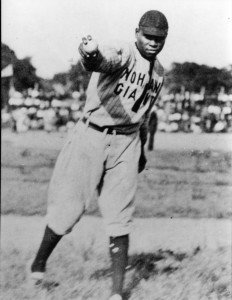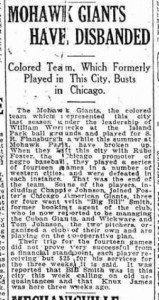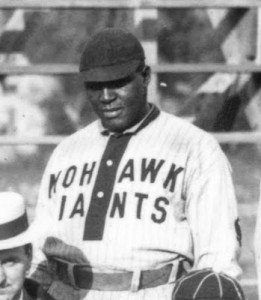 When you discuss Negro baseball, most people think of names like Satchel Paige, Josh Gibson, and Cool Papa Bell. These were some of the biggest stars in the professional Negro leagues. However, this was not the only place where you could see Negro teams play. Throughout the country there were independent teams, like the Mohawk Colored Giants.
When you discuss Negro baseball, most people think of names like Satchel Paige, Josh Gibson, and Cool Papa Bell. These were some of the biggest stars in the professional Negro leagues. However, this was not the only place where you could see Negro teams play. Throughout the country there were independent teams, like the Mohawk Colored Giants.
The Giants got their start in 1913 under the organization of Bill Wernecke. Although this was seasonal work for these ball players, they were full time paid players. By offering full time jobs, Wernecke was able to lure players into Schenectady from all over the country. The Giants would play their home games at the nicest ball field in Schenectady, Island Park.
The beginning of the Mohawk Giants can also be known as the Frank Wickware era. Wickware was by far the best pitcher for the team in its early years. Wickware was known to jump teams often, always playing for whoever paid him the most. In 1914 he pitched no hitters against the Indianapolis ABCs and the Cuban Stars. The Schenectady Union-Star called Wickware “the best colored pitcher in the world.” The ultimate decline of Wickware’s career was an addiction to alcohol. This addiction robbed him of his previous effectiveness and cost him his chance of being inducted into the Baseball Hall of Fame.
 In 1913 the Giants would go on and beat one of the greatest pitchers of all time, Walter Johnson, in a game held in Schenectady and watched by between 6,000-8,000 spectators. Johnson and a team of all-stars came to Schenectady on October 5, and would lose to the Mohawk Giants 1-0 in a game that was called due to darkness after 5? innings. However, this was not even the most interesting event of the day.
In 1913 the Giants would go on and beat one of the greatest pitchers of all time, Walter Johnson, in a game held in Schenectady and watched by between 6,000-8,000 spectators. Johnson and a team of all-stars came to Schenectady on October 5, and would lose to the Mohawk Giants 1-0 in a game that was called due to darkness after 5? innings. However, this was not even the most interesting event of the day.
After both teams warmed up, the Mohawk Giants players ran off the field. The players claimed that the team’s manager, Bill Wernecke, had not paid them for the past six weeks and they demanded to be paid immediately. The Union-Star described the behavior of the players as “disgusting” and “disgraceful,” particularly noting that “Wickware, in an ugly mood, used his tongue too freely as he strode about the crowd, swinging a bat dangerously near the spectators and muttering threats against Wernecke.” Police soon arrived and calmed the crowd, including all spectators that were demanding refunds. Luckily for everyone involved, Alfred Nicolaus, a local restaurant owner and partner in the Mohawk Giants team, was able to send a large portion of the money that the players were looking for down to the ball field. The game finally began an hour and a half after the scheduled 3:00 p.m start time.
Even with early success, the Giants would disappear after the 1915 season, but Independent Negro teams came back to the Schenectady area in 1924 with the emergence of “Chappie Johnson’s All Stars.” Chappie Johnson had been playing professional baseball since 1895 and was one of the best catchers in black baseball during the first two decades of the twentieth century and even played for the Mohawk Giants in 1914. The “All Stars” also introduced the area to a rising star in Buck Ewing, and a new Business Manager in Hank Bozzi.
In 1927 Chappie Johnson would leave the area, but his team stayed and changed its name to “Buck Ewing’s Stars.” The team would continue to play around the area, calling fields as far north as Glens Falls home. In 1929, Buck Ewing left the region and went to play for the Homestead Grays. With Ewing gone, Bozzi decided to rename the team he owned and revived the name of the original black team in Schenectady, the Mohawk Giants. They also had a brand new home, Schenectady’s Central Park.
Buck Ewing was the star that emerged from the Mohawk Giants. Grover Cleveland Alexander stated Ewing was “ the greatest catcher I ever saw, black or white.” Ewing could hit for power and played the position of catcher as well as anyone ever saw. While he did have two productive seasons with the Homestead Grays, at the top level of Negro League Baseball, Ewing is more known for the man that replaced him on the Grays. In 1930 Ewing injured his hand from a foul tip. He was replaced in the lineup by Josh Gibson, who would go on and hit almost 800 home runs in his career. Ewing would return to the Mohawk Giants and have a long, spectacular career. “Introducing Buck Ewing,” the Cobleskill Index once wrote, “the colored Babe Ruth of baseball. If you have seen him play once, you will want to see him again. If you haven’t, then don’t miss him.”
By 1931 the Mohawk Giants were really making a name for themselves. Bozzi reported that the club had an 82 win 27 loss season. Perhaps the most memorable of these games came when the famous House of David came to Schenectady with former World Series hero Grover Cleveland Alexander. It is reported that between 15,000-18,000 spectators showed up for the event.
 When discussing the topic of Negro teams, obviously the topic of racial issues cannot be overlooked. Race relations were most likely not any better or worse in Schenectady compared to other areas throughout the country. It was noted that the Giants most famous player, Buck Ewing, was met with opposition when he rented a place in a white Schenectady neighborhood. Another account stated seeing a Giants player being refused a haircut by a Proctor’s Arcade barber because of the color of his skin. The Giants were in a unique situation in Schenectady, unlike teams from larger urban areas, the Giants relied on a white fan base to support them. For the most part they were treated as Schenectady’s own and respected, but there was always an invisible color line in the city.
When discussing the topic of Negro teams, obviously the topic of racial issues cannot be overlooked. Race relations were most likely not any better or worse in Schenectady compared to other areas throughout the country. It was noted that the Giants most famous player, Buck Ewing, was met with opposition when he rented a place in a white Schenectady neighborhood. Another account stated seeing a Giants player being refused a haircut by a Proctor’s Arcade barber because of the color of his skin. The Giants were in a unique situation in Schenectady, unlike teams from larger urban areas, the Giants relied on a white fan base to support them. For the most part they were treated as Schenectady’s own and respected, but there was always an invisible color line in the city.
The 1937 version of the Mohawk Giants is often remembered as the best group of talent assembled by Henry Bozzi, and also had superstar Buck Ewing returning. The Giants would finish first in the Eastern New York State League in both the first and second half of the season with an overall record of 30-7, and would go on to win the first game in the championship series. However, when they went to Glens Falls to play games two and three, Glens Falls added a couple new minor league players while the Giants had nine players leave for the winter before the series was even over! Glens Falls went on to win the final two games and the championship.
By 1939 Bozzi and the Giants were experiencing financial problems. Bozzi stated that a lack of revenue was due to the fact that Schenectady did not have a fenced in field and many people were able to watch games at no charge. The Giants became a popular road team where they gained a larger net income. During this season the team was also invited to partake in Baseball’s Centennial Program in Cooperstown where Negro baseball was given recognition. The Giants would play the New York Cubans of the Negro National League and lose 6-0.
In 1942 Bozzi would sell his ownership rights to local black businessman MacDonald Lewis. The team was now more known for its past then its current average play. The Giants would only play 31 games and finish the season with a losing record. Because of a lack of games, players often held full time jobs elsewhere in the city. The money from the Giants was no longer lucrative enough to make a living from just playing baseball and they could no longer draw in the big names as they once had. The Mohawk Giants folded in 1943.
For more information on the Mohawk Giants, and other local baseball history- check out the Frank Keetz Collection at the Schenectady County Historical Society.
Photos: Above, Frank Wickware, ca. 1913 (From the Frank Keetz Professional Baseball Collection, Schenectady County Historical Society)- middle, Schenectady Gazette, August 11, 1914 (hat tip agate type)- and below, Harry Buckner, member of the 1913 Mohawk Giants (Courtesy Welcome to Borcher Field).
Nice job Ryan. This is a very interesting piece of history and resonates on many levels.
Did the Giants ever play the Blue Jays? I remember sneaking into Hawkins Stadium to see the Senators play many times. I even paid on occasion especially when they played their Big Club be it the Red Sox or Kansas City!
Ryan,
Great article! I was googling some info trying to find out more about my grandfather Henry Bozzi….this was very nice to read. Do you have more info about him and the Giants? I couldn’t gather your email from this page, can you shoot me an email sometime.
Thanks
Dominick
Bill Wernecke was my great-grandfather. It wasn’t until the advent of the internet that any of us knew about this part of his life. Unfortunately, his irresponsibility didn’t just extend to how he treated his players, he also abandoned his family when my grandmother was young, dropping in and out of their lives for years until his disappeared for good. If any descendants of the Mohawk Giants read this – I’m so sorry for what my great-grandfather did. He was a deeply flawed man who loved baseball, but hurt lots of people. I’m sorry.